Live on the homepage now!
Reader Supported News
Two stories from this past week
On one hand, with severe weather once again gripping the planet and the dangers of our warming world becoming more apparent, present, and urgent, the infuriating antics of West Virginia Senator Joe Manchin dashed the hopes of Democrats yearning for meaningful action on climate change.
As many have noted, Manchin has been playing his game of Lucy and the football (from the classic comic strip "Peanuts") since the beginning of this 50-50 Senate. Just when Democrats seem close to scoring a policy goal, he (either single-handedly or abetted by Arizona Senator Kyrsten Sinema) pulls the ball away, driving a stake into core objectives supported by vast majorities of the party — and often even by the country as a whole.
It’s gotten to the point where, as we noted recently, the rallying cry for Democrats in the midterms has become some version of, “give us two more senators.”
Of course, the frustration with Manchin isn’t new. At the same time, we would do well to remember that the blame is not his alone. The filibuster, employed in its current state by Mitch McConnell, creates a dynamic that blocks meaningful action and provides a smokescreen on accountability. As we considered in a piece titled “More Than Manchin” over a year ago:
“By focusing so much attention on Manchin, we are not presenting the full narrative to the American people. The press is framing this as a fight within the Democratic Party. That lets Republicans waltz by the microphones and cameras without paying nearly enough of a political price for their cynicism and obstructionism.”
While all this remains true, the latest sucker punch from Manchin, who seems to treat good-faith negotiations like a private joke in which only he knows the punchline, hits particularly hard. The specter of our climate crisis hangs over this Earth with foreboding uncertainty. We know it is already bad. We don’t know how bad it might get (a lot depends on what we do know). Or whether we will find a way to remediate some of the damage. It’s an existential crisis, particularly for younger generations who feel it acutely and wonder, as we all should, about the health of the planet they will inherit.
It is difficult to discern exactly what is motivating Manchin on this issue, but many have noted how he has benefited politically and personally (in terms of his net worth and campaign support) from his ties to the oil, gas, and coal industries. Money talks, but it is also temporal. Focusing on short-term gain at the expense of the future and the needs of others encapsulates the struggles our planet faces. Solutions require planning, rethinking, and perhaps foregoing what is easy now for what is necessary later. Although as we see, the “later” is already NOW with climate.
What fixing the planet also requires is science. For all that is going wrong, we should find some hope in the fact that a global team of scientists over the last several decades has put together a picture of the precariousness of our climate that allows us — should we heed the data — to see what is happening and prepare for what needs to be done. New forms of energy and ideas for greater sustainability can help us reexamine our assumptions and reframe our perspectives.
With this truth in mind, let us reflect on another news story from the past week that, as hinted at the top of this piece, points us in a different direction.
The pictures coming from NASA's James Webb Space Telescope have inspired the world. That we are looking back from our little home, only a speck in the vastness of space — what the astronomer Carl Sagan famously called the “pale blue dot” — at the origins of the universe is hard for most of us to comprehend. The images force us to reconsider our senses of time and space. In this framing, the workings — or more accurately, the dysfunction — of our Senate do not mean anything. Our planet itself, in but one solar system of but one galaxy, is of no consequence except to those of us who call it home. The notion that, amid the universe's vast expanse, we are the only planet of life also seems unlikely.
In order to access these images, in order to allow science to open up our cosmos and the mysteries of life, we need people who can make it happen. And it was a welcome addition to coverage of the Webb telescope that more of us got to know about Gregory Robinson, the NASA administrator who put the troubled project back on track. Robinson, “the ninth of 11 children born to tobacco sharecroppers in rural Virginia,” offers an inspiring American story.
In journalism, sometimes you look for juxtapositions to help provide context for the moment — as if by choosing two events, or people, or trend lines to compare, you can allow for greater clarity on both as well as a sense of the larger picture. Pairing Manchin and the Webb telescope provides, I think, an important perspective and hopefully some sense of hope. There is a battle in this country, and in the larger world, between ignorance and knowledge, cynicism and hope. This is not new. These frictions always exist in human society.
It is oftentimes too easy to focus on all that is wrong, for that provides the greatest danger and the most urgent need for action. But we would be wise to not lose a sense of balance, and of all those pushing against degradation and loss — people like Gregory Robinson. We can look up — at the cosmos and at our own futures — to find the inspiration to keep going. In the end, it is better to bet on the helpers more than the obstructionists, the builders more than the destroyers, and the dreamers more than the cynics.
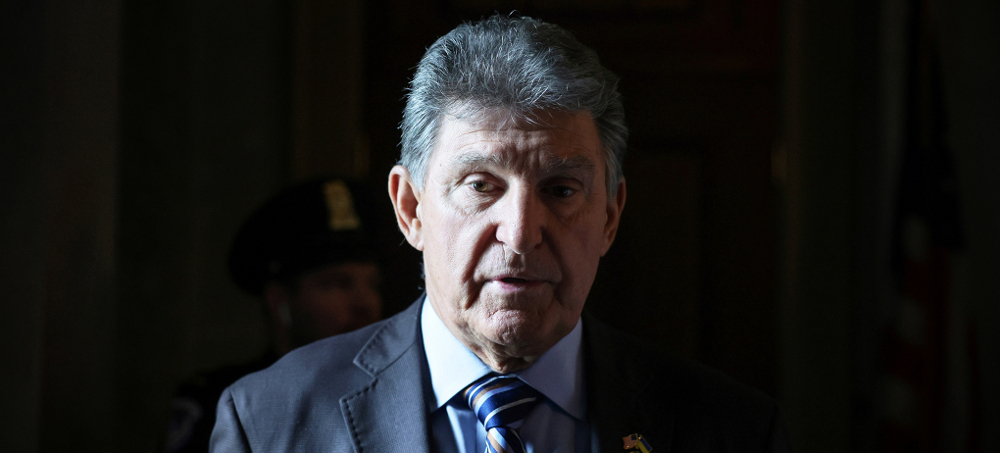 Senator Joe Manchin (D-WV) speaks to journalists in the U.S. Capitol building in Washington, D.C., May 26, 2022. (photo: Evelyn Hockstein/Reuters)
Senator Joe Manchin (D-WV) speaks to journalists in the U.S. Capitol building in Washington, D.C., May 26, 2022. (photo: Evelyn Hockstein/Reuters)
19 july 22
They seem to have all made the same mistake: hearing the nice tones that the West Virginia Democrat said in their private meetings, while dismissing his pessimistic comments in public as standard negotiating ploys.
Instead, Manchin is the odd politician whose public pronouncements, whether in brief Capitol hallway interviews or in detailed prepared statements, carry more weight than whatever he tells his colleagues in private.
This reality came crashing back into play late Thursday when The Washington Post’s Tony Romm and Jeff Stein broke the news that Manchin told Schumer he could no longer support big pieces of their emerging budget bill that would address climate change and raise taxes on the wealthy.
For a few months, Schumer has tried one-on-one talks with Manchin on a slightly slimmed-down version of President Biden’s Build Back Better agenda, focusing on a few health-care items, incentives to rein in climate change and raising taxes on the wealthy. Schumer took on this assignment after the disastrous end to talks that Biden and his senior advisers led last year with Manchin and other Democratic holdouts on the full $2 trillion agenda that included expanded child tax credits, universal pre-K education and more.
Ultimately, just like those White House-led talks, the newer Manchin-Schumer negotiations broke down over the centrist senator’s panic over surging inflation. As Manchin said Friday on a West Virginia radio show, Democrats could take a small deal now that would lower prescription drug costs and shore up health-care premiums, or wait until September to see whether inflation had cooled down enough for him to support a bigger plan.
While some Democrats reacted with rage on Friday, a few said they learned their lesson long ago.
“It’s what, unfortunately, I saw back in December,” Rep. Pramila Jayapal (D-Wash.) said after the House finished its weekly session.
The leader of the congressional Progressive Caucus, Jayapal engaged Manchin in several private talks in the late fall about his support for the BBB agenda. She came away believing him and threw her support behind pushing a $1 trillion bipartisan infrastructure plan that her caucus felt insufficient to addressing climate issues, but she trusted Biden’s own word that he would deliver Manchin for the more ambitious legislation.
A few weeks later, after Biden signed the bipartisan bill into law, Manchin bailed on the broader agenda.
So she was not surprised.
Manchin, Jayapal said, “is not an honest negotiator … somebody who lies to his own president about being willing to get something done and then consistently shows over and over again that he’s not interested in carrying out the Democratic Party agenda.”
Another key Democrat pleaded for all these talks to stay behind closed doors.
“I think the problem has been this continued effort to negotiate in public in the Senate,” said Rep. Richie Neal (D-Mass.), chairman of the House Ways and Means Committee. “It’s the public commentary afterward — we’re near a deal, we’ve got a deal, we’re on the eve of a deal, we’re close to a deal — only to discover that it falls apart.”
But in private, Manchin often allows other negotiators to hear what they want to hear. He says nice things about certain proposals, talks about wanting to get a deal, creating what turns out to be false momentum for the really big deal.
Out in the hallways, after those meetings, Manchin has continually delivered more neutral assessments of where things stood.
His comments to the press Wednesday, after the latest scorching inflation report showed prices continuing to rise, telegraphed his decision Thursday to support only the slimmest of measures.
“I’m very, very cautious. And I’m going to make sure that I have every input on scrubbing everything humanly possible that could be considered inflammatory,” Manchin told reporters that day.
He said it was “not tougher at all” to reach a deal after that inflation report because it only confirmed his fears that he has been talking about for months.
“I was talking about inflation before it was even thought about it. Now I’m more concerned than ever,” he told reporters.
Over the past two years, the Senate has seen several major bipartisan proposals in which ad hoc groups negotiated the frameworks, on pandemic relief in December 2020, infrastructure last year and on gun violence in June.
Manchin was a party to each of those talks but never served as the lead Democrat who clinched the deal.
As the Schumer-Manchin talks started to heat up, the majority leader played the “good cop” role and voiced continued optimism. That helped feed a cycle of belief among other senators, aides and lobbyists working the legislation that a deal would be at hand by the end of July, pushing a steady stream of media stories advancing this view.
“Very good and productive discussions,” Schumer told reporters in late June, before adding an important caveat. “But there are still some issues that have to be resolved.”
Manchin responded to Schumer’s assertions through a staff statement that both sides interpreted however they wanted: The senator, the aide said, “continues to engage in respectful conversations about the best way to move our country forward but is still seriously concerned about harmful inflation taxes hurting Americans.”
Optimists saw him leaning in, figuring the “seriously concerned” portion of the statement was just Manchin using negotiating tactics for leverage. Realists, like Jayapal, viewed that with great hesitation.
“All along I’ve said show me a deal,” she told reporters Friday.
By July 7, Manchin had to issue a formal statement trying to reel expectations back. “Suggestions that a reconciliation deal is close are false,” Sam Runyon, a spokesman for Manchin, said at the time. “Senator Manchin still has serious unresolved concerns, and there is a lot of work to be done before it’s conceivable that a deal can be reached.”
Schumer did not give up and believed this week could prove victorious, scheduling calls and video meetings with Manchin even as he quarantined at home in New York after contracting the coronavirus.
Democrats now must decide whether they accept the smaller, health-care-only deal, or wait another six to eight weeks to see whether inflation cools enough to fit Manchin’s demands.
Some want to take any deal now rather than risking coming up empty in September. "If we are going to go to the altar again and not have somebody say I do, then we would have to take the immediate. So I’m open to finding out what the senator really wants,” Neal said.
During a walking scrum with reporters Wednesday, Manchin grew tired of trying to game out which proposals he would support: “That’s all. I’m done. I’m done. I’m done.”
On Friday’s West Virginia radio show, he said it more simply: If you had just listened closely enough, you’d know that he was never that close to making a deal.
“I am where I have been,” he said.
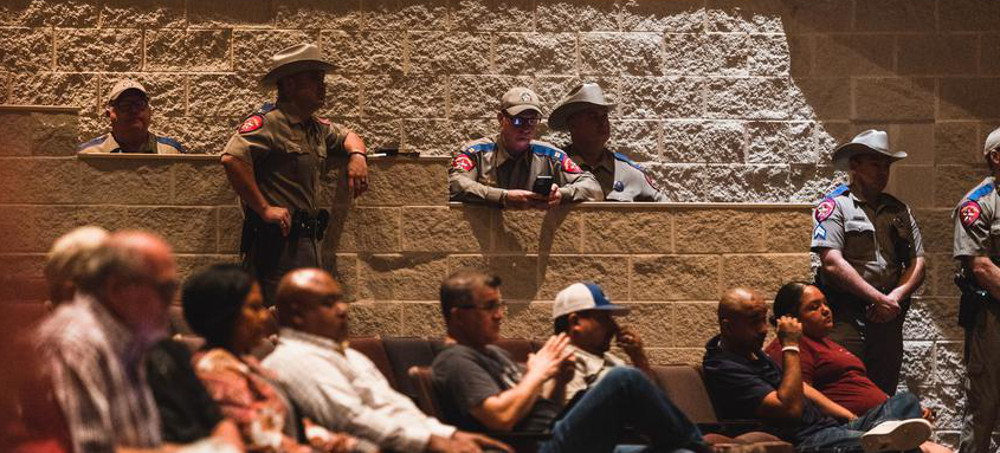 Texas Department of Public Safety officers stand near Uvalde residents at a heated school board meeting Monday night. Parents heavily criticized school officials about school safety and the district police department's response to the May 24 shooting at Robb Elementary. (photo: Evan L'Roy/The Texas Tribune)
Texas Department of Public Safety officers stand near Uvalde residents at a heated school board meeting Monday night. Parents heavily criticized school officials about school safety and the district police department's response to the May 24 shooting at Robb Elementary. (photo: Evan L'Roy/The Texas Tribune)
ALSO SEE: 3 Takeaways From Texas's Investigation
of the Uvalde School Shooting
For about three hours, people demanded the resignation of the school district superintendent and threatened to keep their children out of school until campus security is improved.
The young girl wore the same sundress that she wore to Robb Elementary on May 24, when an 18-year-old gunman massacred 19 students and two teachers.
“Most of those kids were my friends, and that’s not good,” Quintanilla-Taylor’s daughter told school board members and Superintendent Hal Harrell. “And I don’t wanna go to your guys’ school if you don’t have protection.”
For about three hours Monday evening, relatives of the students and teachers killed during the worst school shooting in Texas history demanded the resignation of the school district superintendent, criticized school board members and threatened to keep their children out of school until officials promised to improve campus security.
The school board called the special meeting to let parents and residents provide their thoughts and ask questions about what the district plans to do regarding security for the upcoming school year. Many parents also said they should’ve been given an open platform to voice their concerns much sooner.
The gathering came one day after a Texas House panel report found that nearly 400 law enforcement officers from several agencies descended on the scene of the shooting in a chaotic, uncoordinated response that stretched for 73 more minutes before the gunman was confronted and killed.
The report also found that Robb Elementary’s safety protocols fell short. While its active shooter policy called for classroom doors to be locked, multiple witnesses told the House committee that employees often left interior and exterior doors unlocked or propped open. School staff didn’t reliably receive notices from the Uvalde schools alert system, and some personnel didn’t always respond to them with urgency.
“So I ask you: What are you going to do about your failures? Are you going to take responsibility? Are you going to make this right?” Rachel Martinez, the mother of four children, asked district officials gathered at the Uvalde High School auditorium.
Many parents demanded that Harrell and school board members resign unless they fire Uvalde schools police Chief Pete Arredondo by noon Tuesday. Arredondo was among the first officers to arrive at the school the day of the shooting. For weeks, state leaders have said he was the incident commander and blamed him for law enforcement waiting more than an hour to confront the gunman.
Arredondo, who was placed on administrative leave last month, told The Texas Tribune that he did not consider himself the incident commander. The school district’s active shooter response plan that he co-authored, though, says the chief will “become the person in control of the efforts of all law enforcement and first responders that arrive at the scene.”
“He didn’t do anything and you’re still standing by that,” one resident said about Arredondo. “Y’all do not give a damn about our children or us. Stand with us or against us cause we ain’t going nowhere.”
The House report released Sunday said failures went beyond local police. The report said 376 law enforcement officers from several local, state and federal agencies lacked clear leadership, basic communications and sufficient urgency to take down the gunman. It found that in the absence of a strong incident commander, an officer from another agency could have — and should have — stepped up to the task.
One speaker Monday alluded to the 1970 school walkouts in which Mexican American students in Uvalde demanded equal education to their white peers. The resident of the predominantly Hispanic city questioned if Department of Public Safety officers who responded to the scene saw the victims as important.
“I can’t help but wonder if DPS didn’t think our children were worth saving,” the woman told the school board, noting the dozens of troopers in the auditorium providing security at the Monday meeting.
Vicente Salazar, whose granddaughter Layla Salazar died in the shooting, told the school board that it “hired trash,” referring to the school police department.
Javier Chavez, the cousin of 10-year-old shooting victim Amerie Jo Garza, said as he sees how officials are responding to the shooting, he loses “that much more” respect for the superintendent.
“Y’all are sitting on y’all’s asses,” Chavez told Harrell directly.
The committee’s findings echoed weeks of criticisms by law enforcement experts and Uvalde residents of the police response which they say did not align with the accepted doctrine across law enforcement that officers immediately confront active shooters. A video obtained and released last week by the Austin American-Statesman and KVUE-TV, viewed and reported last month by the Tribune, showed officers’ inaction while children in two classrooms were being killed.
Gov. Greg Abbott on Monday called the House committee’s findings “beyond disturbing” and said there are critical changes needed as a result. DPS said Monday that it launched an internal investigation to determine whether its own officers violated agency standards during their response to the shooting.
Residents also criticized a lack of security measures at Robb and other schools and peppered officials with questions about their plans for increasing safety before another school year starts. The school board was scheduled to vote later Monday on delaying the start of school so it could increase security at campuses but they adjourned without taking such a vote after the open forum ran late.
As parents continued to ask questions and criticize officials’ response to the shooting, school board members on the stage kept their responses to a minimum, repeatedly promising residents and parents that their concerns would be addressed.
“The way things are going, Dr. Harrell, doesn’t look good,” one Uvalde resident said. “I don’t believe it’s gonna end well. I don’t believe it’s gonna end well for any of y’all. Some way, some how, you’re gonna have to face the music.”
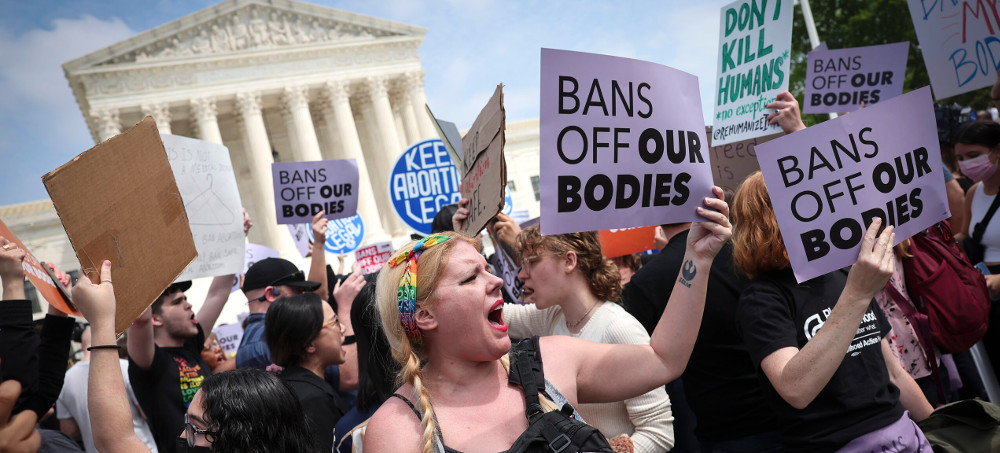 Abortion-rights and anti-abortion activists confront one another in front of the U.S. Supreme Court Building on May 03, 2022, in Washington, D.C. (photo: Win McNamee/Getty)
Abortion-rights and anti-abortion activists confront one another in front of the U.S. Supreme Court Building on May 03, 2022, in Washington, D.C. (photo: Win McNamee/Getty)
19 july 22
The decision, made by Kanawha County Circuit Judge Tera Salango, clears the path for the state's sole abortion clinic – The Women’s Health Center of West Virginia – to restart services.
The Charleston clinic previously suspended services out of fear of prosecution on the heels of the U.S. Supreme Court's June 24 ruling, according to The Associated Press.
The criminal abortion ban made performing or obtaining an abortion a felony punishable by up to a decade in prison. Clinic lawyers argued the law has been superseded by a slew of modern, conflicting laws.
Attorney General Patrick Morrisey decried the ruling Monday, calling it "a dark day for West Virginia.”
He said his office will appeal the decision to the state Supreme Court.
West Virginia has a state law on the books dating back to the 1800s making performing or obtaining an abortion a felony, punishable by up to a decade in prison. It provides an exception for cases in which a pregnant person’s life is at risk.
Abortion rights groups and clinics across the U.S. are seeking to stop or stall bans and restrictions from taking effect in mostly Republican-led states following the Supreme Court's decision last month.
The ruling came hours after a Louisiana judge extended a temporary block on that state from enforcing a "trigger" law ban designed to snap into effect if the high court overturned Roe.
Twelve other states have similar trigger laws. About half of the states have or are expected to seek to ban or curtail abortions following that ruling.
In West Virginia there was no trigger law.
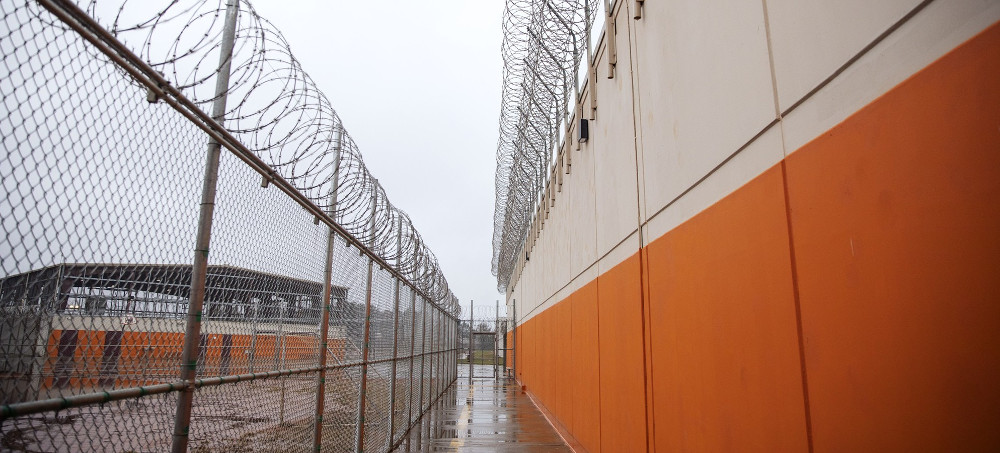 Barbed wire lines a recreation area at the Stewart Detention Center in Lumpkin, Georgia, Nov. 15, 2019. (photo: David Goldman/AP)
Barbed wire lines a recreation area at the Stewart Detention Center in Lumpkin, Georgia, Nov. 15, 2019. (photo: David Goldman/AP)
CoreCivic provided incorrect information to journalists investigating the allegations — and ICE says two investigations remain open.
Two of the internal complaints, one in late December 2021 and one in January 2022, were revealed last week in a letter alleging sexual misconduct by the nurse made to the Office for Civil Rights and Civil Liberties, or CRCL, at the Department of Homeland Security, ICE’s parent agency. The letter was first reported by The Intercept. Two other women who did not file internal complaints also came forward in the letter, meaning that with the revelation of the third internal complaint, a total of at least five women have made sexual assault allegations against the nurse at Stewart.
The documents and interviews also demonstrate that CoreCivic gave at times incorrect information to news organizations.
“Whether it was two or three or five reports that they want to acknowledge, it is far too many to ignore,” said Erin Argueta, an attorney with the Southern Poverty Law Center, one of the groups that organized the letter to CRCL. “This is not an isolated incident, and these allegations are part of a systemic problem. ICE detention fosters mistreatment and abuse. We join the survivors in demanding a thorough investigation and swift action to protect immigrants from further harm.”
The new complaint became apparent when testimony in the letter to CRCL, medical records, and an internal CRCL database obtained by The Intercept through a Freedom of Information Act request did not line up. The third official complaint was then confirmed by CoreCivic when The Intercept requested comment. The database, which lists complaints related to Stewart and includes Prison Rape Elimination Act complaints, listed two allegations of sexual assault against medical staff at Stewart.
With the letter of allegations from the Southern Poverty Law Center and other groups looming earlier this month, The Intercept asked CoreCivic about the two complaints about the nurse through official channels. A spokesperson for the company acknowledged the two official complaints and said they had been investigated and closed: The company’s probes found one complaint to be “unsubstantiated” and another “unfounded.” The spokesperson added that the nurse had “no prior allegations.” That turned out not to be true.
In response to questions by The Intercept about the new revelations, the CoreCivic spokesperson confirmed that one of the internal reports took place in late December, before the two complaints that the company had initially confirmed. “As we continued to review the matter, we found one additional complaint made on a separate occasion.” The spokesperson added that CoreCovic’s investigation also found the additional complaint to be “unsubstantiated.” In a phone call, the CoreCivic spokesperson confirmed that all three complaints were against the same nurse, whose identity, nursing license, and employment at the facility were previously confirmed by The Intercept.
Though only the two January complaints were listed in the CRCL database, another woman’s CoreCivic medical records, which were reviewed by The Intercept, show that there was a previous complaint, originally reported on December 31. That woman, identified in the letter to CRCL as Maria Doe and whose name The Intercept is withholding to protect her privacy, spoke with The Intercept earlier this month but did not realize that her complaint was not listed in the CRCL database. Her internal complaint was confirmed by medical records and in an interview.
In the email to The Intercept, CoreCivic said it followed all of its protocols in response to the December complaint. The company did not elaborate on why the complaint never appeared in the CRCL database and referred the matter to ICE and the Department of Homeland Security.
In addition to the incorrect information provided to news media by CoreCivic, a statement by ICE appeared to contradict CoreCivic’s statements, suggesting that there may have been other internal reports against the nurse.
The day after The Intercept published its investigation into Stewart, ICE sent a statement to CNN saying that its administrative investigation into the initial allegations determined they were unsubstantiated but that “two allegations remain under investigation.” ICE did not clarify which two allegations remain under investigation and declined to comment further to The Intercept. The CoreCivic spokesperson, responding to questions about the discrepancy between the company’s own and ICE’s statements, told The Intercept they did not know what allegations ICE is investigating.
There is no evidence to suggest that the ongoing ICE investigations are related to the nurse. ICE’s national detention standards, which apply to private contractors, say that when a staff member is suspected of sexual assault, they “shall be removed from all duties requiring detainee contact pending the outcome of the investigation.” The nurse has continued to give medical attention to women at Stewart as recently as July 2, according to the Southern Poverty Law Center, which reviewed medical records for that date. There are no public allegations of misconduct related to the July 2 medical records. (Neither CoreCivic nor ICE responded to follow-up questions from The Intercept on whether the nurse has been placed on leave during ICE’s ongoing investigations.)
Public records and reporting by The Intercept indicate that there were at least 11 sexual assault complaints against staff at Stewart from May 2021 to May 2022. With at least five of those allegations against the nurse, The Intercept has been unable to specify how many, if any, of the remaining six allegations were against medical staff at Stewart.
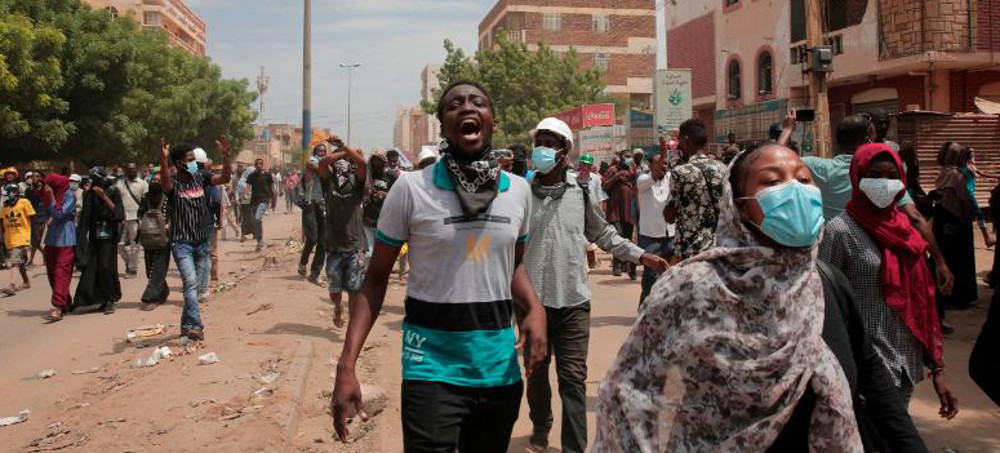 Demonstrators calling for civilian rule and denouncing the military administration on the streets of Khartoum, Sudan, July 17, 2022. (photo: Marwan Ali/AP)
Demonstrators calling for civilian rule and denouncing the military administration on the streets of Khartoum, Sudan, July 17, 2022. (photo: Marwan Ali/AP)
More than 30 people were killed and 100 injured in tribal clashes that started last week between the Hausa and Fung tribes in the southeastern state, close to the border with Ethiopia, according to Sudanese officials and the United Nations.
Authorities said on Sunday they would reinforce the security presence in the state and investigate the clashes. A curfew has been declared in two towns.
Protesters in the capital carried signs reading "Stop Civil War," "Blue Nile is Bleeding," and "Cancel the Juba Peace Agreement," as they marched towards the presidential palace.
There have been sporadic outbreaks of violence in several parts of Sudan including eastern coastal regions and western Darfur, despite a nationwide peace deal signed by some rebel groups in Juba in 2020.
The anti-military movement, which has carried out a campaign of protests since a coup in October 2021, has accused the military of stoking internal conflict and failing to protect civilians.
"The continuation of the coup means more death as we saw in Blue Nile, Darfur, and other places," said Mohamed Idris, a 43-year-old protester in Khartoum.
Military leaders have said their takeover was necessary to preserve Sudan's stability amid political infighting, and that they are working to build on the peace deal in Darfur and other regions.
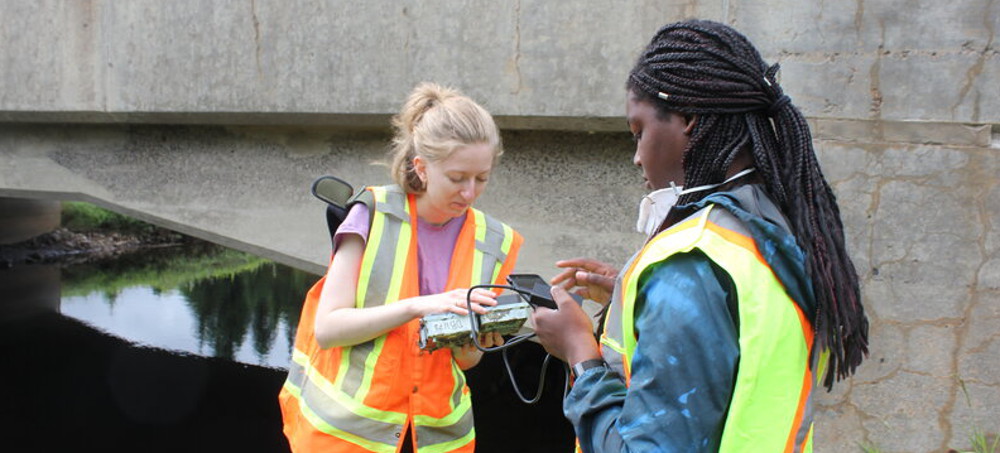 Environmental research students Valérie Bolduc and Jaynina Deku review test photos from motion-activated cameras they have installed around a water culvert to monitor wildlife. (photo: Emma Jacobs)
Environmental research students Valérie Bolduc and Jaynina Deku review test photos from motion-activated cameras they have installed around a water culvert to monitor wildlife. (photo: Emma Jacobs)
"Ack, I am really stuck," says the road ecology student, trying to pull her oversized waders out of a streambed that travels through concrete culverts and the grassy median of Quebec Route 117.
Her predicament makes evident the hazards for wild animals using the same path.
"I do not want to be a deer going through that," Bolduc says.
A warming climate is pushing many animals to migrate toward higher latitudes to remain within their preferred environments, but that comes with risks as they cross dangerous areas, such as highways. In eastern Canada, not far from the U.S. border, Bolduc and other researchers and conservationists are trying to preserve safe corridors for wildlife.
"I might actually need a hand," Bolduc says at last, getting an assist from her colleague, Jaynina Deku, another student at Concordia University in Montreal.
The pair retreat through the culvert, pointing out animal tracks in the muddy edges, mostly raccoon.
The motion-activated cameras they have brought will document which species are using the concrete tunnel. An outward-facing camera will identify what animals approach but do not enter, perhaps deterred by traffic noise, the culvert's size or other factors.
"We're looking at larger megafauna," explains Bolduc, "like bear and moose ... and also just smaller, rarer species."
"Lynx," adds Deku, who once spotted the rare and reclusive animal in photos from a different research site. "Stuff like that."
Bolduc explains that this highway running diagonally through southern Quebec separates a series of Canadian national and regional parks on either side, along with their animal populations.
"It's also super important," she notes, "because of climate change. Because the animals, they want to move north and they encounter these and then can they move through? Will they get hit by a car? Will they sink and perish in the water? We'll need to figure that one out. And we need to help them, at least I want to help them."
Wildlife corridors: an idea that is hitting its stride
Wildlife corridors, an interest in conservation circles for many years, have achieved wider visibility alongside growing concern about the impacts of climate change.
"The idea," says Karen Beazley, a conservation biologist at Dalhousie University in Halifax, "is to create corridors that are relatively wide, that are relatively natural, that have as few roads and human developments as possible. And where there are those barriers to perhaps create things like underpasses and overpasses and things that will help the animals move across them."
In Banff National Park, specially created overpasses and underpasses for animals to cross the coast-to-coast TransCanada Highway have become vital and globally regarded models for preserving connectivity and supporting biodiversity. Banff falls within the Yukon to Yellowstone corridor, the focus of decades of cross-border collaboration between conservation groups and government agencies in Canada and the United States.
Researchers have estimated that species have been shifting poleward an average of around 10 miles a decade to stay within their preferred climate conditions.
For those whose range is shifting from the northeastern United States northward into Canada, "There's a real pinch point," Beazley says, "between the most Eastern Great Lake and the Atlantic Coast."
A crucial area for trans-continental migration under threat
Within that relatively narrow area, development is eating into remaining wild habitat.
Jonathan Cole, who is completing a PhD on wildlife connectivity in this region at Concordia University, has documented increasing fragmentation and steep overall declines in forest and wetland areas in the natural corridor from the Adirondack Park in northern New York State into Quebec and Ontario.
"Over the long period of time," he says, "you'll start to get major extinctions, because the species will not be able to go to where they need to go to thrive in the right environmental conditions."
He says his research has reinforced the need for collaboration between local and federal governments to ensure that animals have routes to travel in the coming decades.
"It all matters on, you know, everybody making the same decisions," he says, since most intact habitat crosses municipal or even national borders.
"Really, each municipality needs to work adjacent with their adjacent municipalities to say, 'Look, we've got this great patch here, let's try to keep that and not put roads through it.' "
It takes more than a village
Other key participants in preserving and restoring wildlife corridors include private landowners, according to Beazley. These include individuals who can commit areas of their properties to land trusts in key areas, as well as industries like agriculture and even wind energy producers.
"If governments and sectors who influence connectivity could really pick up the ball and bear connectivity in mind when they are planning where to do forestry, where to do agriculture," she says, "that's what's going to be needed to have adequate connectivity."
Transportation departments will be able to apply insights gleaned from research projects like that of Valérie Bolduc to modify or design new underpasses for wildlife. Fencing can also be used to direct animals to existing crossing points, with the added benefit of reducing road accidents.
Back at the highway, Bolduc and Deku finish installing their cameras on the northbound side of the highway, but decide they need an alternate path to the other side to avoid another mishap in the mud.
Using an online map, they identify a route involving a short drive to an old rail underpass turned bike path.
"We're generally trying to be safe and everything," Bolduc says, but for the animals, "this is their life!"
Special Coverage: Ukraine, A Historic Resistance
READ MORE
Follow us on facebook and twitter!
PO Box 2043 / Citrus Heights, CA 95611



No comments:
Post a Comment
Note: Only a member of this blog may post a comment.